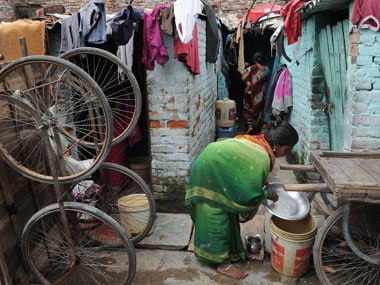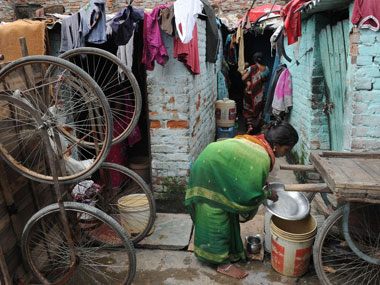New Delhi: Every time polls are round the corner in Delhi, the carrot of the regularisation is invariably dangled in front of the 40-lakh strong community that lives the national capital’s unauthorised colonies. The urban development ministry’s decision on Wednesday to prepare an action plan to regularise all unauthorised colonies in Delhi is perhaps the surest indication yet that the BJP is gearing up for assembly elections. Is this a political gimmick or is the Delhi government really serious this time about getting the job done? For the lakhs of residents living in Delhi’s unauthorised colonies, this is an all too familiar moment. [caption id=“attachment_1675799” align=“alignleft” width=“380”]  Authorising the unauthorised? AFP[/caption] Eight years after the Sheila Dikshit government handed out provisional regularisation certificates ahead of the 2008 assembly polls to 1,218 colonies and almost two years after the same government issued an order listing 895 colonies as ’eligible for regularisation’, neither regularisation nor development has reached a majority of the colonies. While opinion is divided on whether blanket regularisation of unauthorised colonies is the right signal to send, there is no disagreement that the existence of such colonies is the result of government’s own failures. “This happens because there is a systemic failure. First is the failure of the administration to provide suitable accommodation for people who keep flocking to the National Capital Territory for economic reasons. Second, the total abdication of responsibility on the part of the civic agencies in ensuring that encroachments don’t happen. If we have municipal authorities and government functionaries of local bodies who look the other way for reasons which are not difficult to fathom, then unauthorised structures will come up. And then suddenly you wake up because there are pressing humanitarian problems and basic amenities have to be provided. The message that goes down is that you can encroach on government land or uncared for private land and no one is going to mind,” said retired IAS officer KK Jaswal, director of NGO Common Cause, whose PIL in 1993 opposing the government’s regularisation drive led to the 2008 framework of guidelines for regularisation. But some policy experts argue that the lakhs of residents who live in such colonies cannot be punished for the collective failure of successive governments to meet the massive demand for housing in a growing metropolis like Delhi. “The reason why these colonies came up was because there was a lack of affordable housing or lack of government housing. It is well-known that the Delhi Development Authority (DDA) did not meet its targets of LIG, MIG and EWS housing. But Delhi as a city kept growing which is one of the big reasons why these colonies came up in the first place. Hence, ex-post, when the guidelines are being framed by the government, it is an opportunity for the state to say that we have failed in providing public housing and hence we are now putting together a process of regularisation,” says Shahana Sheikh, a Research Associate at the Centre for Policy Research (CPR), who recently co-authored a report on Delhi’s unauthorised colonies titled The Thin Line between Legitimate and Illegal–Regularising Unauthorised Colonies in Delhi. Delhi has over 1,600 unauthorised colonies, some of them over two decades old, that are thriving, highly dense living spaces. It is more practical, argues Sheikh, for the government regularise such colonies than to go on demolition drives. While there is consensus across party lines on the need to regularise, the handling of the process by successive governments has raised serious doubts about the political and administrative commitment to clean up the mess. “They have dealt with the issue in a very ham-handed manner. They have not thought through the issue, they have not tied up all the loose ends. These are knee-jerk and motivated actions at the time of elections. There is no policy consistency. There is no administrative or political commitment to see that some order is enforced,” said Jaswal. Sheikh blames the lack of coordination between the multiple urban local bodies for the lack of movement on the ground. “When you have multiple bodies, in this case, three municipal corporations, the state government and the Delhi Development Authority (DDA), which is the largest land-owning authority in Delhi - these agencies need to coordinate. There was a specific time-line which the DDA notification had laid out. But it is clear, given what we have seen in the past that nobody stuck to those time-lines. While it is important to pass regulations and guidelines, in order to translate it on the ground, agencies have to get activated,” she said. But there is also a more cynical explanation why regularisation is always promised but never delivered. “It seems that in not completing the process properly as per the guidelines set by the government, it is trying to keep these residents in limbo. Most of these residents are holding voter ID cards. They are all voters,” said Sheikh. As the CPR report observes, “Given the significant number of voters that live in these colonies, debate around their status has been Central in at least three consecutive Delhi Government elections, including the most recent in December 2013. Pre-election promises have often included regularisation for UACs (unauthorised colonies).” And sure enough, as Delhi stares at another assembly election, the issue of regularisation has been revived and replayed for maximum public effect. Asked what he would advise the government in its latest attempt to solve a long-standing problem, Jaswal said, “They have to assemble a body of experts who would be able to project the trends of influx into the National Capital Territory of Delhi. And recognise the inevitability of the phenomena and provide for structures of accommodation. They need to make sure that these people have job opportunities in the vicinity so that they don’t have to commute long distances. And so there has to be a parallel activity of providing livelihoods in the vicinity of these housing structures. They should junk the existing master plan and go for a new one.”
While there is consensus across party lines on the need to regularise, the handling of the process by successive governments has raised serious doubts about the political and administrative commitment to clean up the mess.
Advertisement
End of Article


)
)
)
)
)
)
)
)
)



